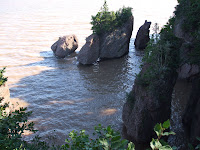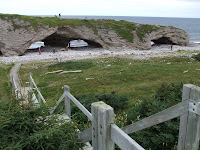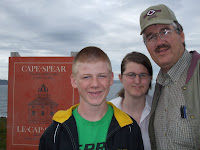
We crossed over to the United States on September 4, 2007. The next day we were enjoying Acadia National Park on the southern shores of Maine. Acadia is actually on an island, and is one of the most-visited parks in the US. We
 started our visit getting the background of the park in the Visitor Center. It was a favorite retreat for the wealthy, like the Rockefellers. We drove the Loop Road, first ascending Cadillac Mountain, which at 1530 feet in elevation is the highest mountain along the America eastern coast. Imagine the views from there....ocean and islands all around. We continued our tour at Sand Beach, which is the only sandy beach in the park. The kids attest that the water was too cold to actually go swimming, but they had lots of fun jumping in the waves. Morgan also collected crabs.
started our visit getting the background of the park in the Visitor Center. It was a favorite retreat for the wealthy, like the Rockefellers. We drove the Loop Road, first ascending Cadillac Mountain, which at 1530 feet in elevation is the highest mountain along the America eastern coast. Imagine the views from there....ocean and islands all around. We continued our tour at Sand Beach, which is the only sandy beach in the park. The kids attest that the water was too cold to actually go swimming, but they had lots of fun jumping in the waves. Morgan also collected crabs.  Thunder Hole is where the in-coming tide makes a roaring sound in an alcove in the rocks. We didn't get the full effect of this as the tide was low. We continued around the loop seeing Otter Cove and Jordan Pond. The scenery was beautiful. We also went to two ranger programs while we were in the park: one slide show about the history of the national parks service, and one called a 'hawk watch' where we sat on Cadillac Mountain with binoculars and identified the birds in the air. We learned a lot at both programs.
Thunder Hole is where the in-coming tide makes a roaring sound in an alcove in the rocks. We didn't get the full effect of this as the tide was low. We continued around the loop seeing Otter Cove and Jordan Pond. The scenery was beautiful. We also went to two ranger programs while we were in the park: one slide show about the history of the national parks service, and one called a 'hawk watch' where we sat on Cadillac Mountain with binoculars and identified the birds in the air. We learned a lot at both programs.Morgan, Elise, and Mason were ready for some "fun" after the last weeks driving and site-seeing. So, they spent some time in the pool, which they loved. We also had lots of fun playing a few rounds of mini-golf at the "Pirate's Cove". That was probably the coolest mini-golf course we've ever been on. :)


From Maine, we moved west into New Hampshire, and camped along the Kancamagus Highway which is famous for its colorful fall foliage. We were abit early, but the leaves were actually starting to change color. And what a beautiful location. The biggest thrill for the kids was when we stopped at a river where swimming was allowed. It was a hot, hot day, and you can imagine that we didn't get any farther for hours to come. The waterfall was fun to sit under, and the kids jumped off the rocks into the water. I'm sure they would have been happy to stay there for weeks. :)




The next morning, we explored our first covered bridge of the trip. It was really neat. We also hiked to some gorgeous waterfalls in rock gorges. We took in the views from the summit of Mount Kancamagus before descending and leaving the White Mountain National Forest. We recommend this area to anyone travelling in Hew Hampshire.


Our next major stop was just as we entered the state of Vermont. Queche (pronounce Kwee-chee) Gorge, in over a mile long and 165 feet deep. The hike down to the river accentuated the heat of the day, but well-worth it.


Another highlight in Vermont was the New England Maple Museum. We sure learned a lot about maple syrup. For example, it takes about 40 gallons of maple sap to make one gallon of syrup. Also, one tree can yield about 16 quarts of sap in one day. At the 'free sample' room we tasted a variety of maple products: syrups, jams, salsa, cookies, candy. A person can sure gain weight there. :) It was also the funnest gift shop we've come across on the trip so far. It's fun to have fun. :)



 is world-famous for its tremendous difference between high and low tide. We saw a
is world-famous for its tremendous difference between high and low tide. We saw a 






































